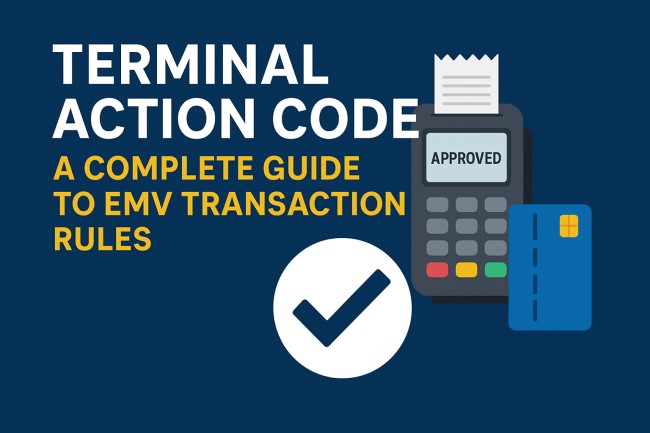Terminal Action Code: A Complete Guide to EMV Transaction Rules

Introduction to Terminal Action Code
In the world of electronic payments, Terminal Action Code (TAC) plays a crucial role in determining whether a transaction is approved, declined, or sent for online authorization. It is a set of programmed parameters in EMV-enabled payment terminals that dictate how transactions are handled based on specific conditions. Understanding TAC is essential for banks, merchants, and payment technology providers to ensure secure and efficient payment processing.
What is a Terminal Action Code?
A Terminal Action Code is a series of settings stored in the payment terminal that defines how it should respond during a transaction when certain risk conditions are detected. TAC works closely with two other elements in the EMV ecosystem:
-
Issuer Action Code (IAC) – Parameters defined by the card issuer.
-
Terminal Verification Results (TVR) – A record of conditions observed during a transaction.
When a payment is made, the terminal compares the TAC and IAC against the TVR to determine the next step: approve offline, request online authorization, or decline.
Types of Terminal Action Codes
Terminal Action Codes are divided into three main types, each serving a specific purpose in transaction handling.
TAC–Denial
Definition: These are the conditions under which the terminal will immediately decline a transaction without attempting to go online for authorization.
Example Use Case: A stolen card indicator is present, or the card is expired.
TAC–Online
Definition: These conditions instruct the terminal to seek online authorization from the card issuer before approving the transaction.
Example Use Case: Transaction amount exceeds the offline limit, or risk parameters require verification.
TAC–Default
Definition: Used when the terminal cannot go online (e.g., network failure) but still detects conditions that require online processing. In this case, the transaction is declined.
Example Use Case: System outage or connectivity loss during high-risk transactions.
How Terminal Action Codes Work
To fully understand TAC, it’s important to see how it interacts with other EMV components during a transaction.
Step 1: Transaction Initiation
The customer presents a card to the terminal. The terminal reads the chip and begins the transaction process.
Step 2: TVR Generation
The terminal generates the Terminal Verification Results (TVR), a five-byte code that records specific transaction conditions such as expired card, floor limit exceeded, or offline PIN failure.
Step 3: TAC and IAC Comparison
The terminal compares the TVR against the TAC–Denial and IAC–Denial.
-
If there is a match, the transaction is declined immediately.
-
If not, the system checks the TAC–Online and IAC–Online conditions.
Step 4: Decision Making
-
If TAC–Online conditions are met and the terminal can connect to the issuer, the transaction is sent online for approval.
-
If TAC–Default conditions are met and no online connection is available, the transaction is declined.
-
If no conditions are met, the transaction may be approved offline.
The Relationship Between TAC and Security
Terminal Action Codes are not just technical configurations; they are part of a risk management strategy. By properly setting TAC values, merchants and payment networks can reduce fraud, manage liability, and ensure compliance with global payment standards.
Key Security Benefits:
-
Prevents high-risk transactions from being approved offline.
-
Forces online verification for transactions above a certain limit.
-
Automatically declines transactions that fail essential security checks.
Setting TAC Values in Terminals
Payment networks and card brands often provide recommended TAC values to ensure standardization across merchants.
Factors Affecting TAC Configuration
-
Business type: A fuel station may have different TAC settings than a retail store.
-
Risk tolerance: High-risk industries may choose stricter TAC–Denial parameters.
-
Regulatory requirements: Certain countries enforce specific TAC configurations.
Example TAC Settings
While values vary, an example for an online-only terminal could be:
-
TAC–Denial:
00 10 00 00 00 -
TAC–Online:
58 40 04 F8 00 -
TAC–Default:
58 40 00 A8 00
Why TAC Matters in Payment Processing
Understanding and correctly implementing Terminal Action Codes ensures that:
-
Fraudulent transactions are minimized.
-
Transactions are processed quickly and efficiently.
-
Terminals remain compliant with payment brand rules.
-
The right balance is maintained between customer convenience and security.
Common Challenges with TAC Implementation
1. Incorrect Configuration
If TAC settings are too lenient, fraudulent transactions may slip through. If too strict, legitimate transactions could be declined unnecessarily.
2. Lack of Updates
Payment terminals must be updated regularly to ensure TAC settings match current fraud trends and compliance rules.
3. Network Dependency
For terminals that rely heavily on TAC–Online rules, internet or network outages can lead to more declines, affecting sales.
Best Practices for Terminal Action Code Management
Regular Review and Updates
Merchants and payment providers should review TAC configurations at least annually, or whenever fraud patterns change.
Test Before Deployment
Before rolling out new TAC settings, test them in a controlled environment to ensure they work as expected without disrupting sales.
Staff Training
Cashiers and store managers should understand why some transactions are declined due to TAC settings so they can explain to customers.
Future of Terminal Action Codes
As payment technologies evolve, TAC will continue to play a central role in transaction risk management. With the growth of contactless and mobile payments, TAC settings may become even more adaptive, potentially integrating AI-based decision-making for real-time fraud detection.
Conclusion
Terminal Action Code is a foundational element of EMV payment processing that directly impacts transaction approval, security, and compliance. By understanding the types of TAC, how they work, and best practices for configuration, merchants and financial institutions can enhance security while maintaining a smooth payment experience for customers. Properly implemented TAC settings not only protect against fraud but also ensure that payment systems run efficiently and in line with global standards.



